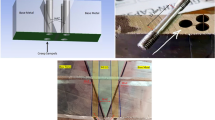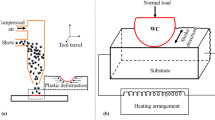Abstract
High strength low-alloy (HSLA) steels have been employed in the automotive industries to produce chassis, part of suspensions, and truck wheels, among others. They present good strength and mechanical toughness, in addition to good formability and weldability. However, good weldability depends on the welding process and parameters. For mechanical components with occurrence of cracks, fatigue life can be quantified by the fatigue crack growth stage. This paper aims to evaluate the fatigue crack growth in HSLA steel plates welded by flash butt welding and laser beam welding. The different welding processes and welding parameters used resulted in their distinct microstructures. The different microstructures showed significant differences in hardness; however, they showed no significant differences in fatigue crack growth. Moreover, the weld beads showed higher resistance to fatigue crack growth when compared to the base metal. For cracks propagating across the weld beads obtained by laser beam welding, with crack initiating at the base metal and growing toward the heat-affected zone and weld bead, a drop in the fatigue crack growth rate was observed as the crack tip approached the microstructure gradient found between these regions.






Similar content being viewed by others
References
European Parliament, “Reducing Carbon Emissions: EU Targets and Measures,” News European Parliament., 2019, pp. 1–3, https://www.europarl.europa.eu/pdfs/news/expert/2018/3/story/20180305STO99003/20180305STO99003_en.pdf.
C.I. Garcia, High Strength Low Alloyed (HSLA) Steels, Automotive Steels: Design, Metallurgy, Processing and Applications, Elsevier, 2017, p 145–167, doi:https://doi.org/10.1016/B978-0-08-100638-2.00006-7.
P. Lu, Z. Xu, K. Jiang, F. Ma and Y. Shu, Influence of Flash Butt Welding Parameters on Microstructure and Mechanical Properties of HSLA 590CL Welded Joints in Wheel Rims, J. Mater. Res., 2017, 32(4), p 831–842. https://doi.org/10.1557/jmr.2016.509
Z. Xu, P. Lu, and Y. Shu, Microstructure and Fracture Mechanism of a Flash Butt Welded 380CL Steel, Eng. Fail. Anal., Elsevier Inc., 2016, 62, pp. 199–207, doi:https://doi.org/10.1016/j.engfailanal.2016.02.005.
K. Min, K. Kim and S. Kang, A Study on Resistance Welding in Steel Sheets Using a Tailor-Welded Blank (1st Report), J. Mater. Process. Technol., 2000, 101(1–3), p 186–192. https://doi.org/10.1016/S0924-0136(00)00476-3
Y. Ichiyama and S. Kodama, Flash-Butt Welding of High Strength Steels, Nippon Steel Tech. Rep., 2007, 95, p 81–87.
C. Xi, D. Sun, Z. Xuan, J. Wang and G. Song, Microstructures and Mechanical Properties of Flash Butt Welded High Strength Steel Joints, Mater. Des., 2016, 96, p 506–514. https://doi.org/10.1016/j.matdes.2016.01.129
L. Li, R. Eghlio and S. Marimuthu, Laser Net Shape Welding, CIRP Ann., 2011, 60(1), p 223–226. https://doi.org/10.1016/j.cirp.2011.03.066
A.P. Mackwood and R.C. Crafer, Thermal Modelling of Laser Welding and Related Processes: A Literature Review, Opt. Laser Technol., 2005, 37(2), p 99–115. https://doi.org/10.1016/j.optlastec.2004.02.017
D. Parkes, W. Xu, D. Westerbaan, S.S. Nayak, Y. Zhou, F. Goodwin, S. Bhole and D.L. Chen, Microstructure and Fatigue Properties of Fiber Laser Welded Dissimilar Joints between High Strength Low Alloy and Dual-Phase Steels, Mater. Des., 2013, 51, p 665–675. https://doi.org/10.1016/j.matdes.2013.04.076
B. Chung, S. Rhee and C. Lee, The Effect of Shielding Gas Types on CO2 Laser Tailored Blank Weldability of Low Carbon Automotive Galvanized Steel, Mater. Sci. Eng. A, 1999, 272(2), p 357–362. https://doi.org/10.1016/S0921-5093(99)00499-2
M. Carboni, S. Beretta and A. Finzi, Defects and In-Service Fatigue Life of Truck Wheels, Eng. Fail. Anal., 2003, 10(1), p 45–57. https://doi.org/10.1016/S1350-6307(02)00036-5
L.H.S. Barbosa, P.J. Modenesi, L.B. Godefroid, and A.R. Arias, Fatigue Crack Growth Rates on the Weld Metal of High Heat Input Submerged Arc Welding, Int. J. Fatigue, Elsevier, 2019, 119(April 2018), pp. 43–51, doi:https://doi.org/10.1016/j.ijfatigue.2018.09.020.
J. Ni, Z. Li, J. Huang, and Y. Wu, Strengthening Behavior Analysis of Weld Metal of Laser Hybrid Welding for Microalloyed Steel, Mater. Des., Elsevier Ltd, 2010, 31(10), pp. 4876–4880, doi:https://doi.org/10.1016/j.matdes.2010.05.034.
D.M. Viano, N.U. Ahmed and G.O. Schumann, Influence of Heat Input and Travel Speed on Microstructure and Mechanical Properties of Double Tandem Submerged Arc High Strength Low Alloy Steel Weldments, Sci. Technol. Weld. Join., 2000, 5(1), p 26–34. https://doi.org/10.1179/stw.2000.5.1.26
J. Neves and A. Loureiro, Fracture Toughness of Welds—Effect of Brittle Zones and Strength Mismatch, J. Mater. Process. Technol., 2004, 153–154(1–3), p 537–543. https://doi.org/10.1016/j.jmatprotec.2004.04.120
T.F.A. Santos, T.F.C. Hermenegildo, C.R.M. Afonso, R.R. Marinho, M.T.P. Paes, and A.J. Ramirez, Fracture Toughness of ISO 3183 X80M (API 5L X80) Steel Friction Stir Welds, Eng. Fract. Mech., Elsevier Ltd, 2010, 77(15), pp. 2937–2945, doi:https://doi.org/10.1016/j.engfracmech.2010.07.022.
X.L. Wang, Y.R. Nan, Z.J. Xie, Y.T. Tsai, J.R. Yang and C.J. Shang, Influence of Welding Pass on Microstructure and Toughness in the Reheated Zone of Multi-Pass Weld Metal of 550 MPa Offshore Engineering Steel, Mater. Sci. Eng. A, 2017, 702(June), p 196–205. https://doi.org/10.1016/j.msea.2017.06.081
M.C. Zhao, K. Yang and Y. Shan, The Effects of Thermo-Mechanical Control Process on Microstructures and Mechanical Properties of a Commercial Pipeline Steel, Mater. Sci. Eng. A, 2002, 335, p 14–20. https://doi.org/10.1016/S0921-5093(01)01904-9
G. Magudeeswaran, V. Balasubramanian, and G. Madhusudhan Reddy, Effect of Welding Processes and Consumables on Fatigue Crack Growth Behaviour of Armour Grade Quenched and Tempered Steel Joints, Def. Technol., 2014, 10(1), pp. 47–59, doi:https://doi.org/10.1016/j.dt.2014.01.005.
R. Oyyaravelu, P. Kuppan, and N. Arivazhagan, Metallurgical and Mechanical Properties of Laser Welded High Strength Low Alloy Steel, J. Adv. Res., Cairo University, 2016, 7(3), pp. 463–472, doi:https://doi.org/10.1016/j.jare.2016.03.005.
R. Ramesh, I. Dinaharan, R. Ravikumar, and E.T. Akinlabi, Microstructural Characterization and Tensile Behavior of Nd:YAG Laser Beam Welded Thin High Strength Low Alloy Steel Sheets, Mater. Sci. Eng. A, Elsevier B.V., 2020, 780(March), pp. 139178, doi:https://doi.org/10.1016/j.msea.2020.139178.
R. Palanivel, I. Dinaharan and R.F. Laubscher, Microstructure and Mechanical Behavior of Nd:YAG Laser Beam Welded High Strength Low Alloy Steel Joints, Optik (Stuttg), Elsevier, 2019, 2020(208), 164050. https://doi.org/10.1016/j.ijleo.2019.164050
ASTM-E384, Knoop and Vickers Hardness of Materials, ASTM Stand., 2012, pp. 1–43.
ASTM E647−13, Standard Test Method for Measurement of Fatigue Crack Growth Rates, Am. Soc. Test. Mater., 2014, i, pp. 1–50.
K.E. Easterling, Solidification Microstructure of Fusion Welds, Mater. Sci. Eng., 1984, 65(1), p 191–198. https://doi.org/10.1016/0025-5416(84)90212-X
H.K.D.H. Bhadeshia and L.E. Svensson, Modelling the Evolution of Microstructure in Steel Weld Metal, Math. Model. Weld Phenom., 1993, pp.109–182.
G. Krauss, Martensite in Steel: Strength and Structure, Mater. Sci. Eng. A, 1999, 273–275, p 40–57. https://doi.org/10.1016/S0921-5093(99)00288-9
A.F. Hobbacher, “Recommendations for Fatigue Design of Welded Joints and Components,” (Cham), Springer International Publishing, 2016, Doi:https://doi.org/10.1007/978-3-319-23757-2
R. Pamnani, T. Jayakumar, M. Vasudevan, and T. Sakthivel, Investigations on the Impact Toughness of HSLA Steel Arc Welded Joints, J. Manuf. Process., The Society of Manufacturing Engineers, 2016, 21, pp. 75–86, doi:https://doi.org/10.1016/j.jmapro.2015.11.007.
L. Lan, X. Kong, C. Qiu, and D. Zhao, Influence of Microstructural Aspects on Impact Toughness of Multi-Pass Submerged Arc Welded HSLA Steel Joints, Mater. Des., Elsevier Ltd, 2016, 90, p 488–498, Doi:https://doi.org/10.1016/j.matdes.2015.10.158.
P. Sundaram, R.K. Pandey, and A.N. Kumar, Effect of the Welding Process and Heat Input on the Fracture Toughness of Welded Joints in High Strength Low Alloy Steel, Mater. Sci. Eng., 1987, 91(C), p 29–38, doi:https://doi.org/10.1016/0025-5416(87)90280-1.
H.K. Lee, K.S. Kim and C.M. Kim, Fracture Resistance of a Steel Weld Joint under Fatigue Loading, Eng. Fract. Mech., 2000, 66(4), p 403–419. https://doi.org/10.1016/S0013-7944(00)00017-5
S. Ravi, V. Balasubramanian, and S. Nemat Nasser, Effect of Mis-Match Ratio (MMR) on Fatigue Crack Growth Behaviour of HSLA Steel Welds, Eng. Fail. Anal., 2004, 11(3), pp. 413–428, Doi:https://doi.org/10.1016/j.engfailanal.2003.05.013.
R.A. Ricks, P.R. Howell and G.S. Barritte, The Nature of Acicular Ferrite in HSLA Steel Weld Metals, J. Mater. Sci., 1982, 17(3), p 732–740. https://doi.org/10.1007/BF00540369
S. Bhambri, V. Singh, and G. Jayaraman, The Effect of Microstructure on Stage-II Fatigue Crack Growth Rates in 2.5 NiCrMoV Steel, Int. J. Fatigue, 1989, 11(1), pp. 51–54, Doi:https://doi.org/10.1016/0142-1123(89)90047-9.
Z. Han, H. Luo, Y. Zhang, and J. Cao, Effects of Micro-Structure on Fatigue Crack Propagation and Acoustic Emission Behaviors in a Micro-Alloyed Steel, Mater. Sci. Eng. A, Elsevier, 2013, 559, pp. 534–542, Doi:https://doi.org/10.1016/j.msea.2012.08.138.
S. Li, Y. Kang, G. Zhu, and S. Kuang, Microstructure and Fatigue Crack Growth Behavior in Tungsten Inert Gas Welded DP780 Dual-Phase Steel, Mater. Des., Elsevier B.V., 2015, 85, p 180–189, Doi:https://doi.org/10.1016/j.matdes.2015.06.083.
M.P. Nascimento, C.C. Batista, B.A. Sorrija, and H.J.C. Voorwald, Fatigue Crack Growth Investigation on a Maintenance Welding Repair Applied on a High Responsibility Airframe, Procedia Mater. Sci., Elsevier B.V., 2014, 3, pp. 744–749, Doi:https://doi.org/10.1016/j.mspro.2014.06.122.
V. Balasubramanian and B. Guha, Effect of Welding Processes on Toe Cracking Behaviour of Pressure Vessel Grade Steel, Eng. Fail. Anal., 2004, 11(4), p 575–587. https://doi.org/10.1016/j.engfailanal.2003.09.005
S. Li, Y. Kang, G. Zhu, and S. Kuang, Microstructure and Fatigue Crack Growth Behavior in Tungsten Inert Gas Welded DP780 Dual-Phase Steel, Mater. Des., Elsevier B.V., 2015, 85, pp. 180–189, doi:https://doi.org/10.1016/j.matdes.2015.06.083.
L. Tsay, C. Chung and C. Chen, Fatigue Crack Propagation of D6AC Laser Welds, Int. J. Fatigue, 1997, 19(1), p 25–31. https://doi.org/10.1016/S0142-1123(96)00049-7
A. Trudel, M. Lévesque, and M. Brochu, Microstructural Effects on the Fatigue Crack Growth Resistance of a Stainless Steel CA6NM Weld, Eng. Fract. Mech., Elsevier Ltd, 2014, 115, p 60–72, doi:https://doi.org/10.1016/j.engfracmech.2013.11.013.
S. Zhang, J. Xie, Q. Jiang, X. Zhang, C. Sun, and Y. Hong, Fatigue Crack Growth Behavior in Gradient Microstructure of Hardened Surface Layer for an Axle Steel, Mater. Sci. Eng. A, Elsevier B.V., 2017, 700(February), pp. 66–74, doi:https://doi.org/10.1016/j.msea.2017.05.104.
L. Tsay, Y. Chen and S. Chan, Sulfide Stress Corrosion Cracking and Fatigue Crack Growth of Welded TMCP API 5L X65 Pipe-Line Steel, Int. J. Fatigue, 2001, 23(2), p 103–113. https://doi.org/10.1016/S0142-1123(00)00081-5
G. Padmanaban, V. Balasubramanian, and G.M. Reddy, Fatigue Crack Growth Behaviour of Pulsed Current Gas Tungsten Arc, Friction Stir and Laser Beam Welded AZ31B Magnesium Alloy Joints, J. Mater. Process. Technol., Elsevier B.V., 2011, 211(7), pp. 1224–1233, doi:https://doi.org/10.1016/j.jmatprotec.2011.02.003.
E.M. Anawa and A.G. Olabi, Control of Welding Residual Stress for Dissimilar Laser Welded Materials, J. Mater. Process. Technol., 2008, 204(1–3), p 22–33. https://doi.org/10.1016/j.jmatprotec.2008.03.047
N. Ma, L. Li, H. Huang, S. Chang, and H. Murakawa, Residual Stresses in Laser-Arc Hybrid Welded Butt-Joint with Different Energy Ratios, J. Mater. Process. Technol., Elsevier B.V., 2015, 220, pp. 36–45, doi:https://doi.org/10.1016/j.jmatprotec.2014.09.024.
Acknowledgments
The authors are thankful to company IOCHPE-MAXION for making the steel plates available. To Eng. MSc. Carla I.S. Maciel for collaboration in some of the FCG tests conducted in this work. H.V. Ribeiro also acknowledges the Coordination of Superior Level Staff Improvement (CAPES) for the scholarship. This research did not receive any specific grant from funding agencies in the public, commercial, or not-for-profit sectors.
Author information
Authors and Affiliations
Corresponding author
Additional information
Publisher's Note
Springer Nature remains neutral with regard to jurisdictional claims in published maps and institutional affiliations.
Rights and permissions
About this article
Cite this article
Ribeiro, H.V., Lima, M.S.F., Marcomini, J.B. et al. Fatigue Crack Growth on Flash Butt Welded and Laser Beam Welded Joints in a High-Strength Low-Alloy Steel. J. of Materi Eng and Perform 31, 7686–7694 (2022). https://doi.org/10.1007/s11665-022-06795-4
Received:
Revised:
Accepted:
Published:
Issue Date:
DOI: https://doi.org/10.1007/s11665-022-06795-4




